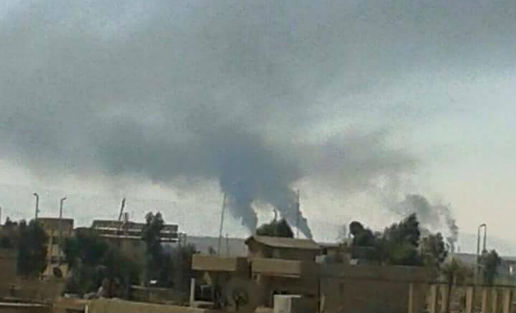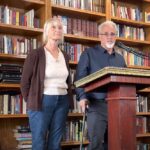
Assyrian Church in Beirut
Most Assyrian Christian families taken hostage in northeast Syria more than two weeks ago remain in Islamic State hands, despite initial reports indicating all, or nearly all, had been released.
Initial news that IS forces had released all the Christian detainees after Friday prayers March 6 was reported to the British-based Syrian Observatory for Human Rights by an Assyrian military commander.
The commander’s informant, he said, was a brother of the Sharia court judge who had ordered their release.
Captured two weeks ago from more than a dozen Assyrian villages along Hassaka province’s Khabour River, the 220 or more Christian hostages include men, women and at least 39 children under the age of 10, according to the Assyrian Network for Human Rights. Of those, 23 were released March 2 and 3.
By the evening of March 6, an Assyrian church leader told World Watch Monitor that “unfortunately” no one could verify the alleged “blanket” release, since none of the remaining hostages had arrived in Hassaka city or even been heard from since their capture.
During the next two days, heavily armed IS militants began a massive attack from the south across the Khabour River, initially taking over three Assyrian villages on the northern side. The offensive was an apparent attempt to conquer the strategic town of Tel Tammar, which would then provide a safe corridor for IS militants across the Iraqi border to Mosul.
But with the help of coalition airstrikes, Kurdish and Assyrian fighters counter-attacked and retook the villages, pushing IS forces back across the river by Sunday night. The battlefront of clashes continues to move back and forth on a daily basis, with unconfirmed casualties on both sides.
On Monday, March 9, the Apostolic Nuncio to Syria, Mgr. Mario Zenari, told Asia News that 52 of the abducted families had been released on March 5 and 6 without any ransom paid. But just hours later, the Nuncio received fresh news, indicating that IS forces had in fact backtracked on the release operation when they suddenly came under attack.
“A few dozen families had already boarded the bus and left the area where they had been kept captive,” the prelate said. But church sources in Hassaka city verify that to date, only the 23 abducted Christians released early last week have returned safely to Hassaka.
“So far, no good news about the around 250 captives, and no sad news,” Rev. Emanuel Youkhana of the Christian Aid Program in Northern Iraq, or CAPNI, noted on March 10. “This keeps the window of hope open. We pray and hope for their safe release and return.”
The previous day, CAPNI managed to send a truckload of medicines, milk and blankets from Iraq for the 1,200 Assyrian families taking refuge in Hassaka city in Syria since their villages fell under IS attack. Kurdish authorities on both the Iraqi and Syrian side of the border facilitated the truck’s passage, Rev. Youkhana said.
“We had asked [IS] to free at least the children and the women, but so far that has not happened,” Catholic Archbishop Jacques Behnan Hindo told Fides News. The cleric said the Assyrian Bishop in Hassaka has told him, “I will say that I am sure of their release only when I see them arrive at the door of the church.”
According to Osama Edward, director of the Sweden-based Assyrian Network for Human Rights. some influential tribal leaders are negotiating with IS forces for the Christians’ release. Interviewed by Lebanon’s An-Nahar newspaper on March 7, Edward noted that the militants’ social media sites had specified that “some Assyrians were released after it was proven that they did not dissent [against] the Islamic State.”
An Assyrian church source in Lebanon, who was quoted in the same article, referred to the “fog” covering attempted negotiations for the Christian hostages, concluding that “the destiny of the abducted Assyrians is unpredictable.”
According to Bassam Ishak, president of the Syriac National Council of Europe, the determined IS battle to control the Khabour region is particularly strategic for the jihadists’ so-called caliphate.
“We are hearing that IS is making preparations now for a big assault, trying to build a ford across the Khabour River,” Ishak told World Watch Monitor. He said an open statement issued by the Christian Coalition for Syria has called on Turkey to raise the water flow from its side of the border, to make it more difficult for IS fighters to cross the river from the south bank to the north.
At the same time, one church source cites “signals” that the Syrian army is about to launch an attack to the east of Hassaka. The Assyrian Network for Human Rights’ Edward said he fears such a maneuver might deliberately provoke IS to retaliate violently against the hostages, since this could serve the interests of the Assad regime, “which wants to show the world the crimes of IS, and him [Assad] as the protector of minorities,” Edward said.
“We’re thankful for the coalition airstrikes,” Ishak said, noting that the IS forces are currently entrenched only 17 kilometers from Hassaka city. “But this is only a temporary solution. We need substantive, quality military help, to protect these thousands of Christians and strengthen the troops on the ground. And we need it fast.”
The current IS offensive in Hassaka marks the third time this century that Assyrian Christians have been targeted for massacre and forced displacement from their homes.
The first occurred in 1915 in Anatolia, when both Armenian and Assyrian Christians were massacred under Ottoman Empire rule at the close of World War I. The Assyrian survivors of this slaughter, known as “Seyfo” in Aramaic, fled to Dohuk in the Mosul province.
There in 1933, a second massacre targeting Assyrian Christians in Semele was launched near Dohuk under the new state of Iraq. These attacks forced the surviving Assyrians to flee across the border into north east Syria, to settle in the Khabour valley region of Hassaka province.
